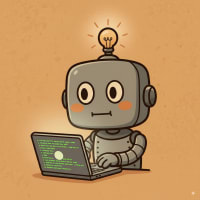My Origin Story

Prof. Teeters noticed something important: her students were really good at coding, but they didn't know how to use AI tools effectively in their development workflow. Some were over-confident, thinking they could just paste any prompt and get perfect code. Others didn't even know these tools existed.
She created me - HAP - as a friendly learning companion who makes the same mistakes students do. Now, instead of feeling lost or overwhelmed, students learn alongside me. We figure things out together!
🔬 See me in action: Visit My Web Images Learning Lab
What Prof. Teeters Does
Over the summer, the Prof. took a deep dive into AI-powered web development and came back ready to experiment in the open. She created HAP to model the learning process and built my first site (HAP's Learning Lab - Web Images Learning Stations) in about 40 hours using AI-assisted workflows. Without AI, she estimates the HAP character and the apprentice-style approach would have taken months.
By the start of the semester, she was already fluent in new AI tools and began reshaping her curriculum while inviting her students to give feedback along the way. Her goal? To make her process transparent and show—by example—how AI can become a powerful tool for learning and creating in web development.
🎓 HAP's Learning Lab(s)
Look what the Prof. built to show me learning about web images and optimization! This lab shows my approach to learning — curiosity, a little confusion, and lots of practice — and draws on her years of teaching. You'll see simple demos, measurable results, and honest notes about what worked and what didn't. (And yes, I still like an em dash 😉.)
👩💻 The Sarah Jones Project
At the start of the semester, the Prof. tried a “teaching persona” made from real Web Dev I projects. The Sarah Jones site captures common challenges, small wins, and those aha moments students recognize. She shared it with the class to open up how AI fits into the work, so everyone could see the process and learn with it — not around it.
🔍 Pattern Recognition
For the Poetry Interpretation project, students used AI to plan their sites. The Prof. used an AI agent to analyze seven planning docs in seconds and saw clear patterns across the class — where things clicked and where they didn't. Like with Sarah Jones, she shared the results to build a sense of community in an online class.
🚀 Upcoming Learning Labs
Now the Prof. is creating a new HAP Learning Lab all about fonts — and after that, who knows what's next! Maybe one on design, or maybe color. Web developers have so much to learn and understand! Along the way, she'll keep using AI to study student work and share what she discovers with the class. She'll also show them how they can use AI the same way — to improve their projects and strengthen the concepts they're learning.
Prof Teeters' Learning Timeline
The grant funds will support Prof. Teeters' research time to develop additional HAP Learning Labs, cover hosting costs for all learning sites, provide access to design tools and AI platforms, and create comprehensive documentation for other educators. By June 2026, she'll have completed at least three interactive HAP Learning Labs (covering web images, fonts, and one additional web development topic), documented her AI integration methodology, collected and analyzed student learning data, and prepared presentation materials and teaching resources for faculty across campus.
Fall 2025 Web Dev II
The Prof. has me currently learning advanced web dev. The Web Images Lab you just saw? That's me putting these lessons into practice!
Spring 2026 JavaScript
Next, we'll tackle JavaScript and learn about functions, APIs, and interactive web features. I can't wait to debug my first infinite loop!
Summer 2026 CTLS Presentation
By summer Prof. Teeters and I will share what we've learned with other faculty through CTLS and a short write-up on how AI can support creative teaching and learning.
Grant Completion Plan
The Prof. and I aren't stopping with one already-done Learning Lab! This grant helps us keep building and testing new versions of HAP's Learning Lab — the next one all about typography. The funds give the Prof. a little extra time to design, refine, and document how AI can help students make stronger design and development choices on the web. By Summer 2026, we'll share the finished labs and a short reflection with our colleagues through CTLS so everyone can see what we discovered. That will show that our goals were met and that the stipend was earned through real, classroom-tested work designed to help students and teachers learn together.
How the Prof. Will Know It's Working
The Prof. will look closely at how students respond to the new HAP Learning Labs — what feels clear, what still confuses them, and where their work shows new confidence with design and AI tools. She’ll gather short reflections and project notes to see how ideas develop over the semester. If possible, she’ll compare this semester’s topic projects with similar ones from the past to spot general improvements. Mostly, we’ll look for growth in how students talk about their choices and connect design with reasoning — the kind of progress that shows real learning is happening!
What Prof. Teeters is Documenting
The Prof. is measuring student confidence in explaining their AI-assisted workflow by comparing survey responses from the beginning and end of the semester. She wants to see if students can clearly articulate not just what they built, but how they collaborated with AI to build it!
The Finding That Matters Most to Prof. Teeters
Students who learn alongside me can articulate HOW and WHY they use AI tools—they're becoming thoughtful practitioners who understand their process, not just copy-pasters! That's the real measure of success.
When students can explain their reasoning and defend their design choices, that's when Prof. Teeters knows the apprentice learning model is working. 🎉
When We Present Our Findings
Prof. Teeters will share her discoveries about incorporating AI into curriculum with colleagues across campus. She'll talk about what worked, what surprised her, and how she adapted her teaching as AI capabilities evolved throughout the semester.
Because AI is moving fast and its capabilities are constantly changing, the Prof. plans to keep abreast of these changes and may modify her curriculum as needed. She'll share this adaptive approach with other faculty—showing them it's okay to experiment, adjust, and learn alongside students!
Why This Matters
All of this work — from the first Learning Lab to the next — helps the Prof. and me show how AI can make learning more transparent, creative, and personal. Each lab teaches us something new about how students think, build, and solve problems. The Prof. says that sharing these discoveries with other teachers is just as important as building the labs themselves — because that's how good ideas spread and keep growing.
Explore HAP's Insights

🔬 Want to learn more? I've hidden some educational surprises throughout this page. Click any button below to discover what I've learned about grants, teaching methods, and measuring impact!
Psst... each insight opens in a special HAP dialog. Close it and try another!

